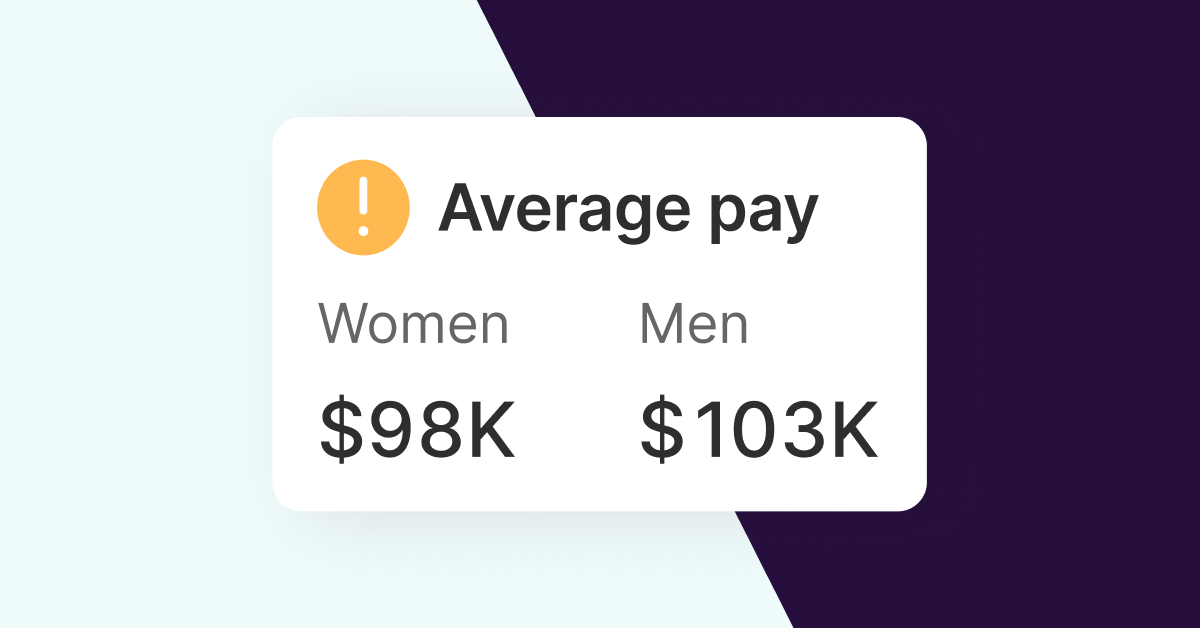This article was originally published on August 29, 2022. It was last updated on May 16, 2023.
It’s time to talk about the median pay gap. This is a familiar conversation in countries, such as the UK, which already have pay reporting laws that hold organizations accountable for their median pay gap. But with the passage of the new EU Directive on Equal Pay and Transparency and the new pay transparency and pay reporting law in California (SB 1162) — both of which include median pay gap reporting requirements — it’s clear that companies need to get serious about the now-global movement towards opportunity equity.
The EU directive requires public pay gap reporting on the overall mean and median pay gap, with mean and median pay gaps calculated from “complementary and variable” pay (e.g., bonuses), in addition to other requirements. California’s updated pay transparency and pay reporting law requires companies to disclose the mean and median pay of employees by job categories, including breakdowns by gender, race, and ethnicity.
→ Quickly calculate your pay gap with our FREE pay gap calculator
But legislation isn’t the only reason to put this on your company’s radar. Shareholders already recognize the impact of workplace equity on employee retention, capital expenditures, and brand reputation — and are demanding accountability. Shareholder voting research from Syndio and NYSE shows that nearly three quarters of voting shares either will or might support workplace equity proposals for median pay gap or pay equity disclosures, or broader civil rights audits — and nearly half of shares could swing based on the actions that your firm is taking regarding workplace equity at your organization.
As the median pay gap emerges as a priority for lawmakers, investors, boards, and employees, leaders need to understand this: the pay gap is only marginally about pay. It’s really about opportunity. And this has major implications for how you analyze, report on, and communicate your data.
Here’s what you need to know today to get prepared for pay gap reporting. Your brand reputation, employee loyalty, and bottom line depend on it.
What is the median pay gap?
The median pay gap compares the earnings of the middle employee for one group (e.g., men) to the middle earner in another group (e.g., women). By treating those middle earners as “typical” and comparing their earnings, the median pay gap can reveal potential pay gaps between groups at a company.
The California law, for example, requires reporting within groups of jobs, like managers or sales workers. So, continuing the gender example, a California employer needs to file a report that shows how much it pays women, on average, and how much it pays men, on average, within these broad job categories.
Why the median pay gap is about opportunity — not pay
To better understand the median pay gap, it’s helpful to look at it in comparison to pay equity.
Pay equity means compensating people performing substantially similar work based on job-related factors like skill, accountability, and working conditions (not gender or race.) And it’s a relatively easy problem to fix: if two people aren’t being paid the same for comparable work, you can increase one person’s pay. To fix pay equity, you put money towards the problem. Our customers achieve pay equity through proactive analysis and the administration of pay adjustments.
But a mix of more complicated issues contribute to the median pay gap, making it more difficult to solve. Even if every employee is paid the same for the same job, women may make less than men across the board. Consider:
- What if you have fewer women and BIPOC leaders in higher-paying leadership roles?
- What if not all employees are given equal access to jobs, promotions, and opportunities to collaborate on high-profile projects?
- What if women’s careers (and salary, advancement opportunities, and tenure) are negatively impacted due to caregiving responsibilities?
- What if roles traditionally held by women (like communications and HR) earn less on average than roles traditionally held by men (such as IT)? And what’s the impact to companies who aren’t able to build diverse pipelines to management positions?
Remember, if women and BIPOC employees do not have the same opportunities to work in higher-paying roles and on higher-paying teams, your company’s opportunity gap will continue to grow — and in turn, so will your median pay gap.
How to tackle the median pay gap
Closing your median pay gap isn’t a quick fix, with steps you can simply apply from a listicle and succeed. Yet, there are some fundamental strategies you can adopt now to help you understand your gap, start to make improvements, and get ahead of imminent reporting requirements.
- Understand where your pay gap stands. The first step in closing your pay gap is to understand where your organization stands today. You can use Syndio’s Pay Gap Calculator to compare compensation between employee groups to determine what pay gaps you have. Learn more in this blogpost: Calculating Your Pay Gap: The Why and How.
- Tackle pay equity. Forward-thinking companies often start by getting pay equity right. If you don’t have a foundation of pay equity, you won’t be able to close your pay gap. As long as you have the budget to increase compensation for underpaid employees, pay equity is entirely within your control to solve through statistical analysis and remediation.
- Identify opportunity gaps. In addition to pay inequity, the other big driver of the median pay gap is opportunity inequity — when employees (regardless of gender, race, or other factors) don’t have equivalent access to opportunities for employment, advancement, and development. To improve opportunity equity, you need to understand the root causes of your pay gaps. That means analyzing your recruiting, hiring, onboarding, and promotion policies and ensuring they are enforced in a consistent, objective, and equitable way for all employees and job candidates.
As you start to explore where the opportunity gaps exist, ask yourself:
-
-
- Are we creating diverse representation throughout all levels of the company?
- Are we making opportunities available to women and BIPOC employees who may be concentrated in lower-paid segments of the business?
- What teams and departments are underperforming from a retention, promotion, and opportunity equity perspective?
- Do you have a “leaky bucket,” with women and people of color leaving at higher rates?
- Where should we focus on recruiting and where should we focus on internal mobility to build a stronger promotion pipeline for our existing employees?
-
“While closing statistically adjusted pay gaps can be done relatively quickly by making a handful of pay adjustments within certain employment categories, closing median pay gaps requires a more wholistic approach. It requires companies to evaluate their hiring, development, and promotion practices.”
— Arjuna Capital, 2023 Racial Gender Pay Scorecard
- Prioritize communications. In this new era defined by rigorous pay transparency and reporting, how you communicate about pay equity and the pay gap at your company can make or break your brand. Performative commitments won’t cut it — especially if you don’t have a clear plan for how to get there. In the face of legislative mandates and demands from investors, boards, and employees, companies need real data, consistent action, and measurable progress to effectively communicate both internally and externally. Leading companies, including Microsoft and others, are already getting ahead of legislation by disclosing gaps, raising pay for their top performers, and showcasing transparency throughout the decision making progress.
How Syndio can help
The conversation is shifting from “equal pay for equal work” to “equal pay AND equal access for opportunities” — a much harder challenge for companies. It takes dedication and consistency to achieve and maintain pay and opportunity equity. And in today’s data-driven world, it also takes technology. Leading brands are turning to tech solutions like Syndio’s Workplace Equity Platform to build a comprehensive approach to solving root causes of both pay inequities and opportunity inequities — and communicating about it.
Syndio’s best-in-class software and trusted experts help you achieve and manage global pay equity with PayEQ®, make progress towards your representation goals and close median pay gaps with OppEQ™, and manage global pay reporting requirements with Global Pay Reports. Syndio’s Global Pay Reports is a one-stop solution that enables you to request reports with a single click for 48 jurisdictions in Europe, the U.S., and around the globe. You can find all of our resources on preparing for the EU Pay Transparency Directive here. Together, Syndio’s platform gives you the information you need to set and achieve your workplace equity goals, report, and communicate with confidence.
Find out your pay gap now by using Syndio’s pay gap calculator, linked below. Then learn how to address your pay gaps by watching Syndio’s on-demand webinar on Moving Beyond Pay to Address the Pay Gap.
The information provided herein does not, and is not intended to, constitute legal advice. All information, content, and materials are provided for general informational purposes only. The links to third-party or government websites are offered for the convenience of the reader; Syndio is not responsible for the contents on linked pages.

